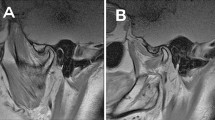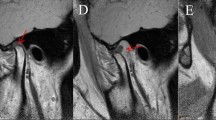Abstract
Objectives
Magnetic resonance imaging (MRI) of the temporomandibular joint (TMJ) and temporomandibular disorders (TMDs) have been discussed in detail for various populations. As no such study has examined the Turkish population, we determined the frequency of TMDs in the Turkish population through a multicentric investigation using MRI.
Methods
This retrospective study examined 504 TMJs of 252 symptomatic patients who had undergone bilateral MRI investigation in four different dental schools. The image analysis included the assessment of disc position and morphology, and recaptured the coronal and sagittal planes in the closed and open mouth positions. The TMJ disorders were classified using the Clinical Diagnostic Criteria for Temporomandibular Disorders (CDC/TMD). The correlations among the groups of TMJs and disc morphologies were analyzed statistically using the chi-square test (P ≤ 0.05).
Results
Disc displacement and abnormal disc morphology were detected in 69.5% of the symptomatic TMJ patients. Of the joints examined using MRI, 154 were normal, 135 had anterior disc displacement with reduction (ADDwR), 145 had anterior disc displacement without reduction (ADDwoR), 30 had partial anterior disc displacement, and 18 had sideways disc displacements. Regarding disc morphology, enlargement in the posterior band was the most commonly encountered type and was observed in 152 TMJs. Overall, the average time for referral for treatment, which was defined as the time from symptom onset until the time of referral, was 1.5 years.
Conclusions
The most common type of disc displacement found in the Turkish population studied was ADDwoR. In addition, patients did not perceive the symptoms of TMDs as a disease and did not seek help until the TMJ derangement caused a major complaint.






Similar content being viewed by others
References
Heffez L, Jordan S. A classification of temporomandibular joint disc morphology. Oral Surg Oral Med Oral Pathol. 1989;67:11–9.
Jensen U, Ruf S. Longitudinal changes in temporomandibular disorders in young adults: indication for systematic temporomandibular joint screening. J Orofac Orthop. 2007;68:501–9.
Abou-Atme YS, Zawawi KH, Melis M. Prevalence, intensity, and correlation of different TMJ symptoms in Lebanese and Italian subpopulations. J Contemp Dent Pract. 2006;7:71–8.
Hussain AM, Packota G, Major PW, Flores-Mir C. Role of different imaging modalities in assessment of temporomandibular joint erosions and osteophytes: a systematic review. Dentomaxillofac Radiol. 2008;37:63–71.
Shahidi S, Haghnegahdar A, Falamaki FN, Khojastehpoor L. Clinical evaluation of internal joint derangement using sonography. Oral Radiol. 2008;24:34–8.
Kurita K, Westesson PL, Tasaki M, Liedberg J. Temporomandibular joint: diagnosis of medial and lateral disc displacement with anteroposterior arthrography—correlation with cryosections. Oral Surg Oral Med Oral Pathol. 1992;73:364–8.
Orhan K, Nishiyama H, Tadashi S, Murakami S, Furukawa S. Comparison of altered signal intensity, position, and morphology of the TMJ disc in MR images corrected for variations in surface coil sensitivity. Oral Surg Oral Med Oral Pathol Oral Radiol Endod. 2006;101:515–22.
Tasaki MM, Westesson PL, Isberg AM, Ren YF, Tallents RH. Classification and prevalence of temporomandibular joint disc displacement in patients and symptom-free volunteers. Am J Orthod Dentofac Orthop. 1996;109:249–62.
Kobayashi K. Efficacy of image diagnosis on temporomandibular joint disorders. Oral Radiol. 2003;19:70–1.
Ma X. Imaging diagnosis and pathological basis of temporomandibular disorders. Oral Radiol. 2001;17:26–30.
Dijkgraaf LC, De Bont LGM, Boering G. Three-dimensional visualisation of the temporomandibular joint: a computerised multisectional autopsy study of disc position and configuration. J Oral Maxillofac Surg. 1992;50:2–10.
Emshoff R, Brandlmaier I, Bertram S, Rudisch A. Relative odds of temporomandibular joint pain as a function of magnetic resonance imaging findings of internal derangement, osteoarthrosis, effusion, and bone marrow edema. Oral Surg Oral Med Oral Pathol Oral Radiol Endod. 2003;95:437–45.
Jagger RG, Woolley SM, Savio L. Signs and symptoms of temporomandibular disorders in Ecuadorian Indians. J Oral Rehabil. 2004;31:293–7.
Fabian FM, Mumghamba EG. Risk factors for signs and symptoms of TMD in a rural southeast Tanzanian population. Cranio. 2008;26:44–9.
Truelove EL, Sommers EE, LeResche L, Dworkin SF, Von Korff M. Clinical diagnostic criteria for TMD. New classification permits multiple diagnoses. J Am Dent Assoc. 1992;123:47–54.
Katzberg RW, Westesson PL. Diagnosis of the temporomandibular joint. Philadelphia: W.B. Saunders; 1993. p. 35–8, 42–3.
Foucart JM, Carpentier P, Pajoni D, Marguelles-Bonnet R, Pharaboz C. MR of 732 TMJs: anterior, rotational, partial and sideways disc displacements. EJR. 1998;28:86–94.
Rutkiewicz T, Könönen M, Suominen-Taipale L, Nordblad A, Alanen P. Occurrence of clinical signs of temporomandibular disorders in adult Finns. J Orofac Pain. 2006;20:208–17.
Milano V, Desiate A, Bellino R, Garofalo T. Magnetic resonance imaging of temporomandibular disorders: classification, prevalence and interpretation of disc displacement and deformation. Dentomaxillofac Radiol. 2000;29:352–61.
Duan X, Junzheng WU, Mao Y, Wang H, Wang M. A retrospective study on the relationship between aging and tomographic findings in 174 patients with TMD. Oral Radiol. 1999;15:9–17.
Kursoglu P, Capa N. Elongated mandibular coronoid process as a cause of mandibular hypomobility. Cranio. 2006;24:213–6.
Emshoff R, Rudisch A, Innerhofer K, Brandlmaier I, Moschen I, Bertram S. Magnetic resonance imaging findings of internal derangement in temporomandibular joints without a clinical diagnosis of temporomandibular disorder. J Oral Rehabil. 2002;29:516–22.
Ogura I. Magnetic resonance imaging characteristics of temporomandibular joint pain during opening and biting in patients with disc displacement. Oral Surg Oral Med Oral Pathol Oral Radiol Endod. 2006;102:669–72.
Kobs G, Bernhardt O, Kocher T, Meyer G. Critical assessment of temporomandibular joint clicking in diagnosing anterior disc displacement. Stomatologija. 2005;7:28–30.
Müller-Leisse C, Augthun M, Bauer W, Roth A, Günther R. Anterior disc displacement without reduction in the temporomandibular joint: MRI and associated clinical findings. J Magn Reson Imaging. 1996;6:769–74.
Rao VM, Liem MD, Farole A, Razek AA. Elusive ‘stuck’ disc in the temporomandibular joint: diagnosis with MR imaging. Radiology. 1993;189:823–7.
Pow EH, Leung KC, McMillan AS. Prevalence of symptoms associated with temporomandibular disorders in Hong Kong Chinese. J Orofac Pain. 2001;15:228–34.
Larheim TA. Current trends in temporomandibular joint imaging. Oral Surg Oral Med Oral Pathol Oral Radiol Endod. 1995;80:555–76.
Sato S, Sakamoto M, Kawamura H, Motegi K. Long-term changes in clinical signs and symptoms and disc position and morphology in patients with nonreducing disc displacement in the temporomandibular joint. J Oral Maxillofac Surg. 1999;57:23–9.
Acknowledgments
This study was presented at the 10th European Association of Dentomaxillofacial Radiology Congress (EADMFR) in Leuven, Belgium, 31 May–3 June 2006.
Author information
Authors and Affiliations
Corresponding author
Rights and permissions
About this article
Cite this article
Arslan, A., Orhan, K., Paksoy, C.S. et al. MRI evaluation of the classification, frequency, and disc morphology of temporomandibular joint disc displacements: a multicenter retrospective study in a Turkish population. Oral Radiol 25, 14–21 (2009). https://doi.org/10.1007/s11282-009-0001-5
Received:
Accepted:
Published:
Issue Date:
DOI: https://doi.org/10.1007/s11282-009-0001-5




